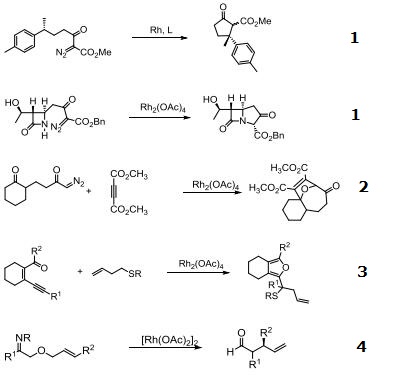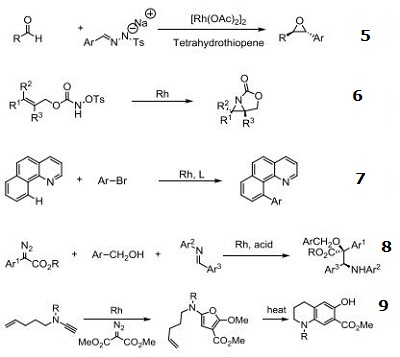Home >> Product >> Noble metals >> Rhodium(II) acetate dimer
- Product Name: Rhodium(II) acetate dimer
- Synonyms: TETRAKIS(ACETATO)DIRHODIUM(II);tetrakis[micron-(acetato-o:o')]dirhodium;RHODIUM ACETATE DIMER;DIRHODIUM(II) TETRAACETATE;dirhodiumtetraacetate
- CAS No.: 15956-28-2
- Molecular Formula: C8H12O8Rh2
- Molecular Weight : 441.99
- Specification : 98%
- Place of Origin: China
- Appearance :
- Document : Download
Description of Rhodium(II) acetate dimer
| Rhodium(II) acetate dimer Chemical Properties | |
| Melting point | 205 °C |
| storage temp. | Store below +30°C. |
| form | powder |
| color | Green to dark green |
| Water Solubility | Soluble in aqueous solution like water. Slightly soluble in ethanol |
| InChIKey | ANSVJOOIUURYRN-UHFFFAOYSA-N |
| Safety Information | |
| Hazard Codes | Xi |
| Risk Statements | 36/38 |
| Safety Statements | 37/39-26-15 |
| WGK Germany | 3 |
| RTECS | VI9361000 |
| TSCA | No |
| HS Code | 28439000 |
| Rhodium(II) acetate dimer Usage And Synthesis | |
| Reaction |
   |
| Chemical Properties | Emerald Green Powder |
| Uses | Rhodium (II) Acetate Dimer is used in the preparation of molybdenum triisopropylbenzoate isonicotinate which maintains ambivalent properties. |
| Purification Methods | Dissolve 5g of the salt in boiling MeOH (ca 600mL) and filter. Concentrate it to 400mL and chill overnight at ca 0o to give dark green crystals of the MeOH adduct. Concentration of the mother liquors gives a further crop of [Rh(OAc)2]2.2MeOH. The adduct is then heated at 45o in a vacuum for 2hours (all MeOH is lost) to leave the emerald green crystals of the actetate. [Legzdins et al. J Chem Soc (A) 3322 1970.] Alternatively dissolve the acetate in glacial AcOH and reflux for a few hours to give an emerald green solution. Evaporate most of the AcOH on a steam bath, then heat the residue at 120o/1hour. Extract the residue with boiling Me2CO. Filter, concentrate to half its volume and keep at 0o/18hours. Collect the crystals, wash them with ice cold Me2CO and dry them at 110o. It is soluble in most organic solvents with which it forms adducts including Me3N and Me2S and gives solutions with different colours varying from green to orange and red. [UV: Johnson et al. Inorg Chem 2 960 1963, Beilstein 1 H 124.] |
| Rhodium(II) acetate dimer Preparation Products And Raw materials | |
| Preparation Products | (1R,2R)-N-BOC-1-AMINO-2-PHENYLCYCLOPROPANECARBOXYLIC ACID |
Please leave your message to us :
( Your Information is an important part of our business,and we will not share or sell any of it to anyone.)
Products
Contact Us
- Email: info@vosunbio.com
- Tel:+86-512-66566131,89888618
- sales extension 8002

